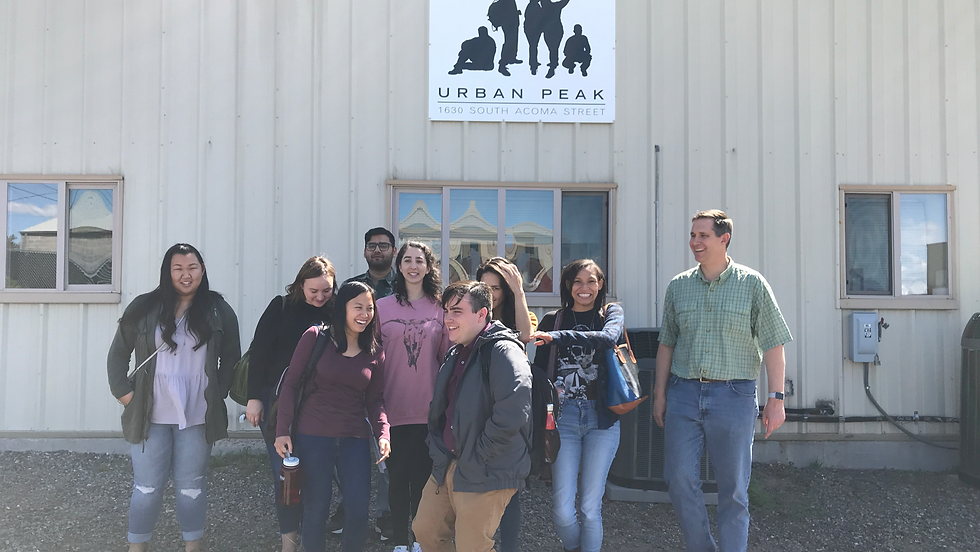DU Students Prioritize the Human in Human-Centered Design
- GC2EH
- Sep 14, 2018
- 3 min read
Updated: Sep 24, 2018
Guest post by Jennifer Wilson & Ellie Adelman
“A young person at Urban Peak [a Denver-based youth shelter] jokingly said, ‘You should try to reach a hospital on foot with a fever of 102 degrees.’ At that point, I considered really trying this as a means of understanding their difficulties in daily life…After my friends dropped me off in an unfamiliar location without my phone, I quickly realized that this was a bad idea, but then I realized that this is how they feel.” A computer science student taking the first ever graduate-level interdisciplinary Human-Centered Design course at the University of Denver (DU) asked to be taken to downtown Denver in an attempt to navigate his way home (without technology). The hope was that in doing so he might gain a small taste of the challenges faced by young people experiencing homelessness every day. It’s a design process that puts human experiences at the core, emphasizing empathy-building in order to create products, services, and systems that better fit the lifestyles, needs, and cultures of the people they are built to serve.
Over the 10-week spring quarter, 13 DU students, representing the disciplines of social work, engineering and computer science, business, emergent digital practice, and international development, wrestled with the design challenge: to understand and promote opportunities for homeless youth to build meaningful connections in their community. Led by Dr. Kimberly Bender of the Graduate School of Social Work and Dr. Matthew Rutherford of the Daniel Felix Ritchie School of Engineering & Computer Science, students partnered with young people at Urban Peak, a local shelter, to empathize, collaborate, and innovate to this end. With a pilot grant from the University of Denver's Center for Community Engagement to advance Scholarship and Learning (CCESL), youth with lived experience were compensated as consultants, lending their time and expertise to the endeavor.

In order to better understand the experience and perspectives of this group of young people, DU students engaged in several weeks of empathy building and research. At a workshop hosted at the shelter, they asked questions like “What does connection mean to you?”, “can you draw us a map of your typical day?”, and “who and what are you connecting with there?” In addition to joining with youth, they heard from service providers and researchers working in the community as well as experts in design, marketing, finance, and consulting. They synthesized their findings, brainstormed ideas, created prototypes, and tested them for feedback from youth. Some teams returned to the drawing board and reworked their ideas completely; some made quick changes to address critiques. By the end of the course, the three DU groups were ready to present the new ideas, not just for a grade, but to show the community that they had carefully listened to their stories and feedback and had designed something feasible, impactful, and truly human-centered.
Some designers and researchers argue that it’s not about the product but rather the process. Coffee mugs and bumper stickers favor a similar quote about the journey versus the destination. No doubt, the final pitches were exceptional: a mobile app that connects young people to safe and affordable events in the community, a partnership between youth shelters and summer camps that provides opportunities for new leadership and youthful life experiences, and a rideshare program that redistributes unused university-issued RTD passes so youth can access strategically identified partnering organizations. But one can’t help but marvel at the process, the journey that connected a group of DU students to a group of youth from a local shelter in such a way that lives were shared, respect was earned, original ideas were generated, and genuine empathy was built. Youth who attended the final presentations lit up when they saw their feedback brought to life and clapped enthusiastically for ideas they’d love to see happen. One young person said that this was the first time they felt truly heard by outsiders visiting the shelter. “Usually people come in once or twice and ask a lot of questions, but we never see anything come from that. I could see all these ideas I talked about in the presentations; that was awesome.” For many of the DU students, that reaction and relationship was the most important product.
Jennifer Hope Wilson, MSW, IMBA, is a PhD student at the University of Denver's Graduate School of Social Work and a Graduate Research Assistant at the Burnes Center on Poverty and Homelessness.
Elie Adelman is a Master's student at the University of Denver's Graduate School of Social Work with over a decade of experience working in international community development and peace-building.




Comments